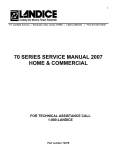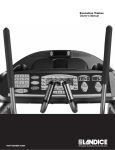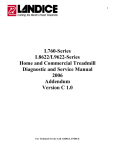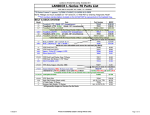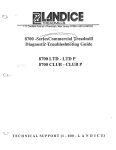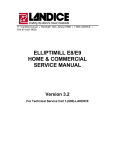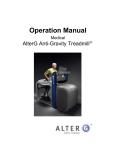Download Landice Finest Treadmills Treadmill User Manual
Transcript
Sport Trainer Owner’s Manual Crafting the World’s Finest Treadmills PART NUMBER 72071 Before you start the treadmill: The red Safety Key must be magnetically connected to the front of the display panel. During operation, removing the Safety Key will cause the treadbelt to stop until it’s replaced. To start the treadmill: START Pressing START powers up the treadmill and all displays will light. The treadbelt will begin moving at 0.5 mph (0.8 km/h). To pause the treadmill: PAUSE Pressing PAUSE will cause the treadbelt to stop, but all statistical information will be preserved. Press either START to resume or QUICK SPEED to a desired speed (see using the QUICK KEYS). To turn off the treadmill: STOP Pressing STOP stops the treadbelt. The treadmill will shut off and all current statistical information will be cleared. To change speed: Hold speed “+” key down to increase speed. Holding speed “+” key depressed for longer than 2 seconds causes the speed to increase at a faster rate. Hold speed “-” key down to decrease speed. Holding speed “-” key depressed for longer than 2 seconds causes the speed to decrease at a faster rate. To change grade: Hold grade “+” key down to increase elevation. Release the button when the display indicates the desired elevation setting. Hold grade “-” key down to decrease elevation. Release the button when the display indicates the desired elevation setting. To view different statistics: Press DISPLAY to choose a different statistic to be displayed. Hold DISPLAY to activate the statistic scan feature. Important Safety Instructions WARNING: Failure to observe the following operating instructions can result in serious injury! [1] If you are suffering from any illness, condition, or disability which affects your ability to run, walk or exercise, do not use this product without consulting your doctor first. [2] If you are suffering from any illness, condition, or disability which affects your ability to run, walk or exercise, do not use this product without supervision present. Failure to do so can result in serious injury should you fall while the treadbelt is moving. [3] Failure to leave ample clearance around the treadmill could result in the user becoming trapped between the treadmill and a wall, resulting in burns or other serious injury from the moving treadbelt. Allow a minimum clearance of 18 inches on each side of the treadmill. Allow a minimum clearance of 4 feet at the rear of the treadmill. [4] Never stand on the treadbelt when starting the treadmill. A sudden start could cause you to lose your balance. Always stand with one foot on each side rail until the belt starts moving. [5] Always wear the emergency stop safety strap securely around your wrist while exercising. Failure to do so can result in severe injuries should you accidentally fall while exercising. [6] Test the emergency stop safety key on a regular basis by pulling on the cord and ensuring that the treadbelt comes to a complete stop. [7] Always remove the safety key from the treadmill when you are through exercising, especially if children are present. This will prevent them from accidentally starting the treadmill. [8] Be sure to familiarize yourself with this manual. Look it over carefully. Be sure you understand the control panel operation before using the treadmill. When using an electrical appliance, basic precautions should always be followed. Read all instructions before using. DANGER: Always unplug the treadmill before cleaning or removing the motor cover. To reduce the risk of electric shock in the event of an electrical storm, always unplug the treadmill from the electrical outlet immediately after using. SAVE THESE INSTRUCTIONS i Important Safety Instructions WARNING: To reduce the risk of electric shock or injury to persons: [1] An appliance should never be left unattended when plugged in. Unplug from outlet when not in use. [2] Close supervision is necessary when this unit is used by or near children or disabled persons. [3] Use this treadmill only for its intended use as described in this manual. [4] Never operate this treadmill if it has a damaged cord or plug, if it is not working properly, or if it has been damaged. Call your selling dealer immediately for examination and repair. [5] Keep the power cord away from heated surfaces. Be sure the line cord has plenty of slack and does not get pinched underneath the treadmill when it elevates and de-elevates. [6] Never operate the treadmill with the motor cover air openings blocked. Keep the air openings free of lint, hair, and dust. [7] Never drop or insert any object into any opening. Be sure no objects are near or underneath the moving treadbelt when you are using the treadmill. [8] Do not use outdoors. [9] Do not operate where aerosol (spray) products are being used or where oxygen is being administered. [10] Connect this appliance to a properly grounded dedicated outlet only. [11] To disconnect, press the STOP button, remove the Safety Key, and unplug the unit from the wall outlet. GROUNDING INSTRUCTIONS This product must be grounded. If it should malfunction or break down, grounding provides a path of least resistance for electric current to reduce risk of electric shock. This product is equipped with a cord that has an equipment grounding conductor and a grounding plug. The plug must be plugged into an outlet that is properly installed and grounded in accordance with all local codes and ordinances. 120 VOLT TREADMILLS Treadmills marked 120 VAC are intended for use in a nominal 120-volt circuit with a grounding plug. Make sure the product is connected to an outlet having the same configuration as the plug. No adapter should be used with this product. 200 - 250 VOLT TREADMILLS Treadmills marked 200-250 VAC are intended for use on a circuit having a nominal rating more than 120V and are factoryequipped with a specific cord and plug to permit connection to a proper electric circuit. Make sure the product is connected to an outlet having the same configuration as the plug. No adapter should be used with this product. If the product must be reconnected for use on a different type of electric circuit, qualified service personnel should make the reconnection. DANGER: Improper connection of the equipment-grounding connector can result in a risk of electric shock. Check with a qualified electrician or serviceman if you are in doubt as to whether the product is properly grounded. Do not modify the plug provided with the product. If it will not fit in the outlet, have a proper outlet installed by a qualified electrician. ii Table of Contents Basics Introduction. . . . . . . . . . . . . . . . . . . . . . . . . . . . . . . . . . . . . . . . . . . . . . . . . . . . . . . . . . . . . . . . . . . . . . . . . . . . . . . . . . . . . . . . . . . . . . . 1 Assembly Instructions. . . . . . . . . . . . . . . . . . . . . . . . . . . . . . . . . . . . . . . . . . . . . . . . . . . . . . . . . . . . . . . . . . . . . . . . . . . . . . . . . . . . . . . 2 Getting Started. . . . . . . . . . . . . . . . . . . . . . . . . . . . . . . . . . . . . . . . . . . . . . . . . . . . . . . . . . . . . . . . . . . . . . . . . . . . . . . . . . . . . . . . . . . . . 4 Manual Mode. . . . . . . . . . . . . . . . . . . . . . . . . . . . . . . . . . . . . . . . . . . . . . . . . . . . . . . . . . . . . . . . . . . . . . . . . . . . . . . . . . . . . . . . . . . . . . 5 Heart Rate Monitoring Overview . . . . . . . . . . . . . . . . . . . . . . . . . . . . . . . . . . . . . . . . . . . . . . . . . . . . . . . . . . . . . . . . . . . . . . . . . . . . . . . . . . . . . . . . . . . . . . . . . 6 My Target Heart Rate Zone . . . . . . . . . . . . . . . . . . . . . . . . . . . . . . . . . . . . . . . . . . . . . . . . . . . . . . . . . . . . . . . . . . . . . . . . . . . . . . . . . . 7 Heart Monitors (Wireless and AccuTrack) . . . . . . . . . . . . . . . . . . . . . . . . . . . . . . . . . . . . . . . . . . . . . . . . . . . . . . . . . . . . . . . . . . . . . . 8 Getting The Most Out of Your Workouts Should You Walk or Run? . . . . . . . . . . . . . . . . . . . . . . . . . . . . . . . . . . . . . . . . . . . . . . . . . . . . . . . . . . . . . . . . . . . . . . . . . . . . . . . . . . . 10 Optimizing Your Workouts . . . . . . . . . . . . . . . . . . . . . . . . . . . . . . . . . . . . . . . . . . . . . . . . . . . . . . . . . . . . . . . . . . . . . . . . . . . . . . . . . 11 Maintenance Maintenance. . . . . . . . . . . . . . . . . . . . . . . . . . . . . . . . . . . . . . . . . . . . . . . . . . . . . . . . . . . . . . . . . . . . . . . . . . . . . . . . . . . . . . . . . . . . . . 12 Appendices Appendix A: Medrail Installation . . . . . . . . . . . . . . . . . . . . . . . . . . . . . . . . . . . . . . . . . . . . . . . . . . . . . . . . . . . . . . . . . . . . . . . . . . . . 13 Introduction Congratulations! You’ve made a very smart investment! Your Sport Trainer treadmill is a high-quality fitness tool that will give you years and years of fitness benefits. One of the great things about the Sport Trainer is its diversity of applications. It’s terrific for just starting out on a walking program or easy jog. In the case of a veteran runner, it’s the exact prescription needed for precision interval training to lower your 10K time. Regardless of the application, unpleasant weather is not an obstacle. Cold, windy, wet days will never discourage you again, nor will the heat and humidity of the summer months. If you’re the type of person that likes to do two things at once, now you can watch your favorite program on TV or keep an eye on your kids and take care of your health at the same time. Your treadmill was a smart purchase, but you already knew that, so let’s move on and get started. BEFORE YOU BEGIN These are some things you should do before you start to exercise on your treadmill: INSTRUCTION MANUAL Be sure to familiarize yourself with this manual. Look it over carefully. Be sure you understand the control panel operation before using the treadmill. WARRANTY INFORMATION Fill out your warranty registration card and mail it in today. Landice backs your treadmill with a strong warranty. For the factory to respond to any problems you may have, we need your warranty information on file. Do it today. Landice will send you a complimentary Landice T-shirt upon receipt of your warranty registration card. SELECTING A LOCATION Install your treadmill in a climate controlled room. Allow a minimum clearance of 18 inches on each side of the treadmill. Allow a minimum clearance of 4 feet at the rear of the treadmill. Failure to leave ample clearance at the rear of the treadmill could result in the user becoming trapped between the treadmill and the wall should the user accidentally trip and fall while exercising. Be sure the line cord has plenty of slack and does not get pinched underneath the treadmill when the treadmill elevates up and down. Make sure the treadmill is plugged into a dedicated line. 1 Assembly Instructions STEP 1: Unbolt treadmill from pallet • On L7 treadmills it is necessary to remove the bolts which hold the treadmill to the pallet. • Start by removing the top bolts. • Lay the treadmill on the ground, and then remove the bottom bolts by placing the treadmill on your toolbox. • With the bolts removed, the treadmill will be free to move around in the box. STEP 5: Prepare to install hand rails (For Med Rail Installation: In steps 5-8, handrails simply refer to the 4” black clamps) • The handrail mounting bolts have been threaded into the rails for shipping. Remove them. • Attach both handrails by first hand-starting the bolts through the upright and then using a 1/2” socket. Leave about 1/8” of slack. (DO NOT TIGHTEN FLUSH TO SURFACE). STEP 2: Cut the box off the pallet STEP 3: Unstrap the treadmill • Remove the metal strapping • The treadmill components around the box. are held together with plastic • Using a razor blade knife, cut the strapping. box just above the bottom row • Carefully cut and remove the of brass staples along all sides strapping. Remove the treadmill of the box. upright and accessory boxes • DO NOT cut through the from the treadmill. Lift the center of the box, as you could treadmill off the pallet. damage the treadmill. • Carefully remove the upright • Remove the box and discard. side cover from the upright assembly. STEP 6: Place crossbar • After mounting both handrails, gently lower the curved crossbar into position between them. • Each end of the crossbar should cover the two smaller access holes that are cut into the handrails. • Leave contact heart rate connection harness hanging for now. STEP 7: Secure crossbar • Using an extended 2” socket, carefully guide the 2 inch bolt with lock washer into the big access hole in the side of the handrail. • Once the bolt reaches the crossbar, tighten it. • Repeat this step with the other handrail. STEP 4: Secure upright to frame • Slide the upright down onto the 8-side frame bolts. • Tighten bolts with a 7/16” extended socket. STEP 8: Secure Hand Rail • Press the dome plugs into the large access holes on the side of the handrails. • Finish tightening the handrail bolts from STEP 5. • Note: Med Rails go to appendix A on page 30. 2 Assembly Instructions *OPTIONAL Contact Heart Rate Assembly Skip to Step 11 if treadmill has standard crossbar STEP 9: Connect contact bar • Feed the contact heart rate harness through the access hole in the inside of the left upright (insert strain relief provided). Feed harness up into the control panel. • Pull back the membrane and connect harness to white 3-pin connector on side of display board. STEP 10: Ground contact bar STEP 11: Snap upright cover • Unscrew the unused screw on the top of the upright where the contact harness enters the control panel. • Feed the screw through the green grounding wire eyelet and rescrew it back into place. • Put the membrane back into place. • Carefully align the upright cover to upright. Working from top to bottom, snap the upright cover into place. STEP 12: Install upright end cap • Press the plastic end cap into the upright carefully fitting the plastic pins into the small bosses in the aluminum. • Align the upright cover beneath the end cap and install the Phillips head screw. • Tighten the Phillips head screw until side cover aligns with endcap (Do not over-tighten). STEP 13: Check drive belt tension STEP 14: Route the wire harness STEP 15 Adjust the treadbelt STEP 16: Install motor cover harness • Check the tension on the drive belt by placing the drive belt between your thumb and forefinger and twisting. • The proper twist is 45˚. If the belt needs to be adjusted use a 7/16” socket and turn the bolt underneath the motor pan attached to the motor’s hook screw. 3 HOME TREADMILL: • The treadbelt is tracked and • Remove the black motor cover • Route the wire harness tensioned via the take-up screws in the side of the frame. underneath the elevation motor screws located at the back of the Place motor cover onto and secure with harness restraint treadmill. treadmill. clip provided. Plug connector • Check the tension of the • Attach motor cover with Phillips into circuit board until it snaps treadbelt. At proper tension you head screws provided. Place into place. should be able to place your rubber spacer between cover and hand between the belt and deck frame. COMMERCIAL TREADMILL: and reach the center of the • Plug treadmill into a dedicated • Route the wire harness behind treadmill. If you cannot reach 15A outlet. Walk on treadmill at the elevation motor and secure the center, the belt is too tight approximately 2.5 mph for 20 to with harness restraint clip and must be loosened. If your 45 minutes to properly walk in provided. Plug connector hand reaches past the center the lubricant. into circuit board until it snaps belt is too loose and must be into place. tightened. Getting Started Make sure you have read and understand this owner’s manual. Now you are ready to begin. Start by straddling the treadbelt with one foot on each traction strip. Press the START button. The treadbelt will begin to move at 0.5 mph. You will be asked to enter your weight (defaulting to 155 lbs.). The center display will show: Note: Your body weight is used to calculate calories burned during a workout. Press to scroll to your body weight. Once your weight is displayed, press START or wait three seconds to begin your workout. The center display now shows the time statistic and you are now in Manual Mode, where you control speed and elevation. Note: To switch from English to Metric units and vice versa, press the Speed “-” key, Grade “-”, and START at the same time while treadmill is OFF. 4 Manual Mode Upon exiting the weight input screen the treadmill enters the Manual mode. In this mode you control all of the treadmill functions. Any changes in speed or elevation will be a direct result of you touching the control panel. In the Manual mode you can view one of the 6 statistics by pressing holding or all of them by and activating the scan feature. Display options: TIME DISTANCE ELEVATION CALORIES PULSE PACE 5 Time logged on treadmill Miles logged on treadmill Incline of treadmill Total calories burned User’s current pulse User’s Current Mile Pace Minutes: Seconds Kilometers when in metric Percent Grade Based on user’s weight Optional Feature (see Heart Rate Monitoring) Minutes: Seconds Heart Rate Monitoring OPTIONAL The Sport Trainer treadmill offers a wireless heart rate monitoring device to give you feedback on how your body is affected by your workout. We will take a look at a few basic concepts of heart rate monitoring so you can better understand how it all works and how to maximize its use to allow you to reach the fitness level you desire. What is exercise intensity? Exercise intensity is simply a measure of how hard you are working at a given time during exercise. The American College of Sports Medicine (ACSM), the world’s leading medical and scientific authority on sports medicine and fitness, recommends that every individual involved in an exercise program know how hard his/her body is working during exercise. Your heart provides key information for determining how intensely you are working during exercise. Your heart rate (how many times your heart beats per minute) is really an efficiency rating for your entire body. The number of times your heart beats during each minute of exercise is a measurement of the intensity of the exercise. If your heart rate is low, exercise intensity is low; if your heart rate is high, your exercise intensity is high. What is maximum heart rate? Maximum Heart Rate (MHR) is the maximum attainable heart rate your body can reach before total exhaustion. True maximum heart rate is measured during a fatigue or “stress” test. This test must be done in a clinical setting and is not practical or accessible for most people. Fortunately, your maximum heart rate can be established with a high degree of accuracy using the following simple formula: Estimated Maximum Heart Rate = 220 minus your age. If John is 35 years old, what is his estimated maximum heart rate? 220 -35 John’s Estimated Maximum Heart Rate = 185 WARNING: The use of this formula assumes no underlying heart or respiratory disease or other condition, which could be adversely affected by exercise. Consult your doctor before using this chart!!! 185 beats per minute is the estimated maximum number of times John’s heart can beat before his body would fatigue or “max out.” This number is extremely helpful because it tells us the absolute highest exercise intensity John can handle before his body wears out. The ACSM says that during exercise, John should keep his heart rate below his maximum so that he will not become exhausted and have to quit. In fact, the ACSM gives John a specific percentage range of his maximum heart rate to exercise in, known as his Target Heart Rate Zone. 6 Heart Rate Monitoring OPTIONAL Why should I monitor exercise intensity? Your heart is the most important muscle in your body and, like all muscles, must be exercised regularly to remain strong and efficient. According to fitness experts, exercise is more effective when you work out in a specific heart rate range or zone. This is referred to as your Target Heart Rate Zone (THRZ) and is reflected by the number of beats per minute your heart pumps. This zone can vary greatly depending on your age, fitness level, and various other factors. If your heart rate is too low during exercise, your body reaps little or no benefit. This means you’re not likely to see the results you want, like weight loss or increased endurance. If your heart rate is too high during exercise, you may tire too quickly and become frustrated, or even run the risk of injury. Monitoring exercise intensity helps you to stay at a level of exercise that allows you to accomplish your goals. In fact, the ACSM recommends that, in order to get the most benefit from your cardiovascular exercise, you should work within your THRZ for at least 20 to 60 minutes per workout, 3 to 5 times per week. Knowing your exercise intensity (heart rate) will allow you to work at the right level of exercise to accomplish this. How do I determine my Target Heart Rate Zone? Your THRZ represents the minimum and maximum number of times your heart should beat in one minute of exercise. The ACSM recommends that all individuals should work within a Target Heart Rate Zone of 60% to 85% of Maximum Heart Rate. This means that your heart rate during exercise should not fall below 60% or rise above 85% of your maximum heart rate. Let’s look at John from our earlier example. John is 35 years old, so his estimated maximum heart rate is 220 minus 35, or 185 beats per minute (bpm). The ACSM says that John should exercise between 60% and 85% of 185 beats per minute to stay in his THRZ. Let’s determine John’s THRZ: John’s Estimated Maximum Heart Rate: Lower Target Limit: 185(MHR) X 0.6 Upper Target Limit: 185(MHR) X 0.85 John’s Target Heart Rate Zone 185 bpm 111 bpm 157 bpm 111-157 bpm 111-157 beats per minute is the range or zone John will want to keep his heart rate in during exercise in order to achieve his goals. If John is a beginning exerciser, he’ll want to stay at the low end of his THRZ. If John is a more advanced exerciser, he may want to work at the higher end of his THRZ to challenge himself more. DIFFERENT INTENSITY LEVELS WITHIN A TARGET HEART RATE ZONE Beginner: Weight Loss: Aerobic: 60% of MHR 75% of MHR 85% of MHR What is a heart monitor? A heart monitor is a device that calculates your pulse. It detects your pulse through two small electrodes that touch your skin and transmit the signal to a receiver in the treadmill. Some heart monitors are built onto treadmills (metallic grips), while others work wirelessly (chest strap). 7 Heart Rate Monitors OPTIONAL The Sport Trainer offers two separate heart rate monitoring systems: The wireless heart rate chest strap transmitter (OPTIONAL) and the AccuTrack Contact Heart Rate Monitoring System (OPTIONAL). Heart rate monitors KEEPS YOU SAFE Exercising too hard can put you at risk for injury. A heart rate monitor reminds you of the safe and effective heart rate intensity at which you should exercise and warns you when your workouts go too far. KEEPS YOU IN YOUR ZONE If you want to reach your exercise goals, it’s important to stay in your target heart rate zone during workouts. A heart rate monitor is your constant reminder of the intensity and quality of each workout session. SAVES YOU TIME Our heart rate monitor is wireless and easy to use, so you can view valuable heart rate information at any time during exercise without interrupting or stopping your workout. WIRELESS HEART RATE CHEST STRAP TRANSMITTER (shown below) To use the Wireless Chest Strap follow these steps: SECURE THE CHEST STRAP Center the transmitter on the chest as high under the pectoral muscles (breasts) as possible. Tighten the strap so that the belt is as tight as possible without being uncomfortable. APPLY CARDIO GEL TO THE ELECTRODES A tube of Landice Cardio Gel was shipped with your Sport Trainer treadmill. Pull the belt away from your chest and apply a small dab to each electrode. This will ensure a strong electrical contact between the transmitter and your chest. The Heart Rate Transmitter works best against bare skin. Since sweat (saltwater) is an electrical conductor, the transmitter will work over a T-shirt if the shirt is wet with sweat. If you are having trouble getting an accurate pulse reading, try wearing the belt against bare skin. CARE AND MAINTENANCE The transmitter activates when the belt is properly wetted. In order to conserve battery life, wipe the electrodes dry when not in use. Clean monthly with mild soap and water and wipe dry. Do not use abrasives in cleaning, as they can cause permanent damage to the electrodes. Do not bend or stretch the electrode strips, especially when storing the belt transmitter. 8 AccuTrack Contact Heart Rate Monitor™ OPTIONAL The AccuTrack Contact Heart Rate Monitoring System™ can be used in place of the wireless chest strap to perform any of the following functions: • Monitor your Time in Zone • Help you maintain your Target Pulse • Maximize workout efficiency 1. Use the NEXT button to switch to one of the three screens that shows Pulse (see above). 2. Grab on to the pulse grips. 3. As soon as you put your hands on the grips a heart will beat on the display. This indicates that the system has been activated. 4. The heart will “beat” briefly and then display your heart rate. Your heart rate will be continuously monitored while your hands remain on the grips. NOTE: If you are wearing the wireless chest strap, the AccuTrack system will override the wireless signal while your hands are on the bar. Once you release the AccuTrack bar, the treadmill then default back to the wireless chest strap signal. The AccuTrack system is designed to be used at walking speeds. A natural running motion involves using your arms to maintain balance. Since contact heart rate systems require your arms to remain stationary, we recommend using the system only at speeds of less than approximately 4 mph (6.4 km/h) or the fastest speed at which you are comfortable walking. 9 Getting the Most Out of Your Workouts Should you walk or run? This depends on several things such as body weight, fitness goals, and what you like to do. Walking is the safest, most compatible form of exercise for most people. If you’re just starting out, are new to exercise, or participate in aerobic activities less than three times per week, we recommend that you walk. On the other hand, if you’re an experienced runner, stick with your program — use your treadmill the way you want. Here are some considerations to keep in mind: [1] If you’re interested in weight control, walking can burn as many calories as a moderate running pace. To get a very small increase in caloric expenditure, you have to run fast and, for most people, the extra effort isn’t worth it. [2] Your chance of losing weight successfully is far greater with walking. Walking increases your daily caloric expenditure, raises your metabolism, and is easier to stick with than running. [3] Heavy users should always walk until they’ve shed some extra pounds and are closer to their desired body weight. Extra weight means extra stress on joints and muscles, which in turn means residual muscle soreness. [4] If you’re concerned about getting a “tough” workout and don’t think walking is adequate, try walking up a hill! You can get just as much cardiovascular intensity (heart rate and breathing response) from walking as you can from running. Don’t fool yourself with preconceived notions about walking -- you can sweat just as much by walking as by running. Take it easy! Walk. Lose weight in comfort. Avoid being sore and discouraged. After you’ve reached your target weight, reevaluate. If you like walking and want to stick with it, terrific. On the other hand, if some running is appealing, try it out and see what it’s like. Just remember that walking will get you fit and keep you fit. 10 Getting the Most Out of Your Workouts FREQUENCY OF EXERCISE Walkers: Runners: Walk 3-6 times a week; 20-60 minutes per day. Run 3-5 times a week; 20-60 minutes per day. DURING YOUR WORKOUT • Stay in the middle portion of the treadbelt. • Monitor your breathing. Can you carry on a normal conversation or are you out of breath? If you use the heart rate method of monitoring intensity, are you within the heart rate zone? • Change the speed and incline as needed to stay within the breathing and heart rate criteria. AFTER YOUR WORKOUT • Drink a large glass of water (you’ll recover faster). • Do some light stretching exercises. • Record that you completed the workout on your calendar. KEEPING TRACK OF PROGRESS • Keep a calendar that shows scheduled and actual workouts. • Record every workout you complete. • Compare planned with actual workouts completed. Aim for 90% completion. If you’re averaging less than 90%, reevaluate your schedule and examine why you’re missing 10% of your workouts (and the extra benefits from those missing workouts). CALORIE COMPUTATIONS • Calories and calories/hour are calculated using the formulas developed by the ACSM. There are two different equations. One is for walking and one for running. The ACSM uses the walking equation for speeds less than or equal to 3.7 mph. The running equations are used for speeds in excess of 3.8 mph. • The computations are based on a 150-pound person, which is a close enough estimate for most people. If you wish the equations to be more precise, you may enter your weight into the treadmill (see Getting Started). 11 Treadmill Maintenance DANGER: Lethal voltages and moving parts capable of causing serious injury are exposed when the drive housing cover is removed. Under no circumstances should the motor cover be removed except by a Landice factory-authorized technician. TRACKING (pre-set from factory, but may need adjustment during installation) The treadbelt is tracked by means of the two 9/16” hex head bolts at the back end of the treadmill. Tightening (clockwise) the adjustment bolt on the side of the machine that the belt has moved towards, and loosening the bolt on the opposite side an equal amount, will cause the belt to move towards the center. Adjustments should be made with the treadmill running, and should be made in 1/4-turn increments. Allow at least 30 seconds for the belt to stabilize between each adjustment. Run the belt at high speed (6-8 mph). To insure proper belt tracking and alignment, the treadmill must be placed on a stable and level surface. A yellow warning label will show at the rear of the treadmill when the treadbelt is not tracked correctly (L8 and L9 only). TREADBELT TENSIONING (pre-set from factory, but may need adjustment during installation) Need for tension is indicated by uneven belt speed, and may be sensed by sudden stopping of the treadbelt when your foot comes down on the belt. To check belt tension, run treadmill at 1 mph. Then, walk on machine. If belt does not feel like it is slipping/hesitating, then belt is tensioned correctly. If belt slips/hesitates, then belt is not fully tensioned. The same hex head bolts used for tracking also tension the treadbelt. To tighten the treadbelt, turn both bolts clockwise exactly the same amount a 1/4-turn at a time. Failure to turn them equally will affect belt tracking. DO NOT OVER-TIGHTEN. Continue checking for treadbelt slipping. Once treadbelt is fully tensioned, speed up treadmill to 5 mph. Then, while jogging lightly, check for any sudden slipping/hesitating of the treadbelt. Repeat treadbelt tensioning instructions if required. MOTOR DRIVE BELT TENSIONING (pre-set from factory) The drive belt is tensioned by a nut located under the motor pan. This nut is screwed to a hook, which is attached to the motor bracket. By turning the nut clockwise, you will tighten the nut pulling down the motor bracket, which will tighten the drive belt. DO NOT OVER-TIGHTEN. If you over-tighten this belt you will snap the motor shaft. To measure the tension, twist the drive belt between the motor and the drive roller. The ideal tension will allow you to twist the drive belt 45º. If you can twist the belt past 45º, it is too loose. If you cannot twist the belt to at least 45º, it is too tight. WARNING: Moving parts can cause serious damage. Be sure to unplug treadmill before placing hands underneath the treadbelt!!! TREADMILL LUBRICATION & CLEANING It is recommended that you vacuum around and underneath the treadmill on a monthly basis. Your treadmill will last longer and look better if you wipe the sweat off the unit after each workout. Lubrication is not required on residential treadmills. In institutional settings Landice recommends lubricating the underside of the treadbelt with Landice SlipCoat on a monthly basis. MOTOR BRUSHES Motor brushes should be checked every six months on institutional treadmills and after six years on home units. Service Check-List • Tension and track treadbelt • Lubricate belt and vacuum treadmill • Check drive belt tension • Check motor brushes 12 Appendix A: Medrail Installation STEP 1 Insert the side rail into the upper rail clamp and tighten the bolt using a 1/2” socket. STEP 2 Fit the side rail to the bottom rail clamp. (Do not over-tighten.) STEP 3 Use a soft mallet to firmly set the rails inside the clamp. 13 STEP 4 Use a 3/16” allen wrench to tighten the rail clamp bolts. (Return to Step 9 in Assembly Instructions). Crafting the World’s Finest Treadmills 111 Canfield Avenue, Randolph, NJ 07869 · 1-800-LANDICE · Tel. 973-927-9010 · Fax 973-927-0630 · www.landice.com





















